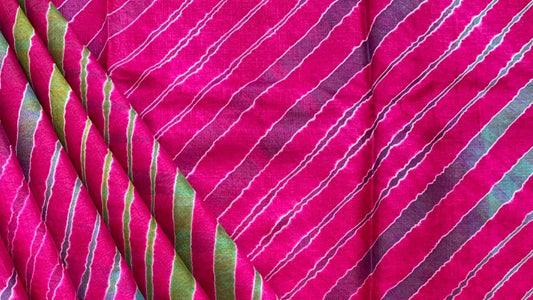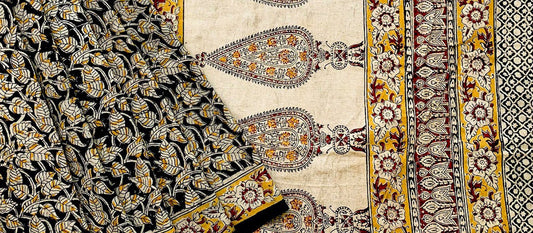
Pen Kalamkari Sarees
In India, Kalamkari sarees have been worn for at least 2,000 years. It's a kind of cotton or silk textile that has been hand-block-printed (Pedana Kalamkari) or hand-painted (Srikalahasti Kalamkari). Here we will talk in detail about the latter, which is quite exquisite and much sought after form of the Kalamkari Art.
Kalam, which means Pen, and Kari, which means Workmanship, are two Persian terms that are combined to form the name Kalamkari, because of the colors, patterns, and design cues that evoke mystical shapes, Kalamkari is renowned for its ability to heal both physically and spiritually.
History
From the 13th to the 19th century, groups of singers, musicians, and painters known as Chitrakattis traveled from village to village spreading Hindu mythology stories through street plays, particularly in the Indian state of Andhra Pradesh. They continued to share these stories in order to make a living. Gradually, the Chitrakattis developed fresh concepts to aid the public in comprehending what they were attempting to convey. Thus, using simple tools and plant-based dyes, they painted the tales directly on the big canvases where their plays were being performed. According to legend, these storytellers traveled from village to village carrying enormous rolls of canvas painted with natural dyes and colors, adorned with storyboards depicting scenes from epics and other cultural literature. In addition to the Kalamkari canvas, they used traditional dance styles like Kathakali to assist tell these tales.
Designs & Making of Pen Kalamkari
The main tool used by artists in the Srikalahasti style to outline and fill in the motifs with natural dyes is a pen. This design is well-known for its elaborate pallus and borders on sarees. Epic tales and religious myths are frequently portrayed in the designs. Images of everyday life from the kingdom are woven into the designs, including floral motifs, the Tree of Life, and animals like parrots and peacocks by skillfully hand drawing and hand painting each color/ outline on a pre- prepped base fabric using natural mordants like buffalo milk, cow dung etc. Hence an authentic hand painted pen kalamkari saree will always have a pale yellow base(where no color is applied) and smell of raw milk. This smell goes away after some use and washing/airing but can be indeed a parameter to judge if the piece is authentic apart from the painted portions having vegetable dyes seeping through which is not the case of a screen or black printed kalamkari saree.
Colors
In this entire process, extensive use of natural materials like leaves, fruits, flowers, and bark of trees. Natural dyes are made using color extracts from fruit peel, roots, leaves, and mineral salts. The colors that are mostly used in this saree are blue, red, black, yellow, and green. The red signature color is made from a solution of alum, tamarind seed powder, and Indian madder root. Yellow color is extracted from pomegranate peel and mango bark, similarly blue from Indigo, and black from iron ore. Authentic Pen Kalamkari sarees are made with natural colours using vegetable dyes. The real handmade kalamkari sarees will always be of earthy muted tones with a faded look. They will never be vibrant or brightly colored as that is impossible to achieve with natural dyes.
Pen Kalamkari sarees, renowned for their exquisite hand-painted designs on cotton and silk fabrics, have captured the hearts of fashion enthusiasts worldwide. VEMSHALA, a trusted brand, brings this ancient art form to your doorstep through its exclusively designed and curated collection of Pen Kalamkari sarees, available online.




